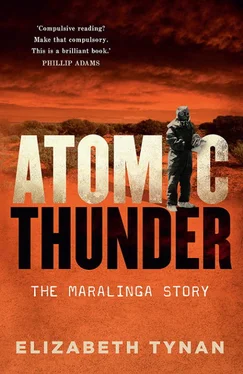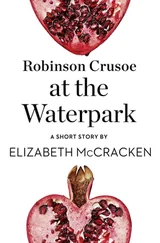Other realities have to be faced too. Australia, not Britain, was left with severely contaminated territory requiring remediation that took several years to complete. Money was finally squeezed out of a resistant UK, but it covered less than half the cost of the most recent clean-up. And the controversies continue. The 1990s remediation plan was devised using guidelines provided by the IAEA and the International Commission on Radiological Protection. It was monitored by ARPANSA and agreed to by the Maralinga Tjarutja traditional owners. This plan involved securing 500 000 cubic metres of contaminated waste from the tests in 21 pits at the site. When it was completed in 2000, Australian prime minister John Howard called it the ‘world’s best practice clean up’. But nuclear engineer Alan Parkinson, sacked from the clean-up, and Jim Green, an anti-nuclear activist, among others, continue to criticise its inadequacies.
The clean-up project used the expensive electronic technique in situ vitrification, which involved placing electrodes in the pits and running an electric current of up to 4 megawatts through the buried debris, raising it to temperatures up to 2000 degrees Celsius and effectively turning it to glass. But it did not go as planned. The vitrification equipment exploded while in operation at pit 11 (the 13th ‘melt’ in the clean-up program) and sprayed molten material from the pit about 50 metres all around. Fortunately no workers at the site were injured. But the vitrification process was abandoned before all 21 pits were processed, and the remaining waste pits were capped with concrete. The glassy material that had been vitrified was excavated and reburied amid fears that it was too close to the surface. Recently, some media reports have claimed that the Maralinga pits are subsiding and eroding, creating fears that the contamination is not permanently secure. Nevertheless, in March 2003, minister for Science Peter McGowan triumphantly tabled the final MARTAC Report in parliament. MARTAC hailed the clean-up as successful.
Alan Parkinson vociferously disagreed, saying that ‘of the hundreds of square kilometres contaminated, only 2.1 square kilometres have been cleaned to the clean-up criterion and, of that, only 0.5 kilometres permits unlimited access. The only people who claim the [clean-up] project a success are paid by the government’. Stuart Woollett, an ARPANSA scientist involved in the clean-up, presented a different view: ‘The release of the MARTAC report marks the end of the considerable work of health physicists, radiation chemists, plant operators, security personnel, surveyors, camp staff, senior public servants, seed planters – the list goes on. Operations, beginning in 1996, have rehabilitated the Maralinga lands for their return to the Maralinga-Tjarutja’. Gregg Borshmann addressed the ongoing controversy in a Background Briefing documentary titled ‘Maralinga: the fall out continues’, that aired on ABC Radio National in April 2000. Every so often, public disquiet about Maralinga still bubbles to the surface.
The Maralinga story is filled with outrages. A story that began to appear in the Australian media in September 2001 described one particularly distasteful aspect of the saga, namely the analysis of (mostly) babies’ bones to detect radioactive fallout. At a meeting in Harwell on 24 May 1957 attended by Ernest Titterton, along with his confreres from the AERE and the AWRE, a variety of sampling tests was ordered, including soil, vegetation, milk and sheep bones. And babies’ bones.
As many samples as possible are to be obtained (the number available is expected to be small). The bones should be femurs. The required weight is 20–50 gm. Wet bone, subsequently ashed to provide samples of weight not less than 2 gm. The date of birth, age at death and locality of origin are to be reported.
Every cliché of the mad, obsessed scientist is entangled in that quote from the report presented to the AWTSC on 11 June 1957. This fact about the British tests ignites public sentiment like few others. Where the tests intersect with the tragedies of infant deaths, few Australians are likely to be unmoved. Many of these concerns centre firmly on Titterton. The meeting minutes recorded that ‘Prof. Titterton will ensure that arrangements are made by the Australian Safety Committee for collection of all of the above samples and despatch them to the U.K. along with all relevant information, addressed to Dr. Dawson, A.W.R.E., who will pass them to A.E.R.E.’
The bones were scattered far and wide, from Australian laboratories in Adelaide and Melbourne to British ones in Aberdeen, Liverpool and London. The parents of the babies never knew. In all, bones from nearly 22 000 bodies – the majority of them babies – from both Australia and Papua New Guinea formed part of the experiments. Collection of samples in Australia was part of a bigger international program perhaps ironically titled Project Sunshine. The bones were tested for strontium-90. John Moroney from the AWTSC said in a letter to the pathologists involved (quoted in an Adelaide Advertiser article many years after the event), ‘You may have perhaps considered it possible that the question of sampling and radiochemical assaying of bones would not be regarded kindly by the general public. Consequently, I would be grateful if… you could treat this matter as either confidential or personal’. While a rational argument can be made that testing bone for traces of radio-activity during the early days of the atomic age has valid scientific justification, no amount of reasoning is likely to reassure the families of the 22 000 babies and others whose bones were tested. Stealing the bones of babies can never be seen in purely scientific terms.
Then there are the nuclear veterans. These aggrieved men, their wives or widows and their children have never been recognised for what they endured. Service personnel who go to war have well-recognised and justifiable rights. Service personnel who stood with their backs to an atomic mushroom cloud, or who scraped the spoilt soil into pits or washed down the aeroplanes that had flown through a high atomic cloud do not enjoy the same rights. The various veterans’ associations in Australia and the UK have fought against this intrinsic injustice for many years, with little success. John Keane summed it up in The Age in 2003:
Five decades after entering service, the thousands of British and Australian men who have survived Maralinga (more than a quarter of them are now dead) feel hurt and humiliated. They have no medals to pass on to their grandchildren, no letters of praise or apology from Tony Blair or John Howard, no wartime veterans’ privileges. What they do have are anecdotes about unusual clusters of multiple myelomas. Hip and spine deformities. Teeth that are falling out. Poor eyesight. Bleeding bowels. Post-traumatic anxiety and depression. And perhaps up to a quarter of them, according to preliminary data collected by the New Zealand government, have disabled offspring.
Despite many court cases and claims for monetary recompense, only a relatively small number of Australians – military and civilian – have been compensated for health problems alleged to have been caused at Maralinga or the other test sites. Documents associated with the Australian Participants in British Nuclear Tests (Treatment) Bill 2006 provided the following statistics:
Since the conclusion of the British Nuclear Testing Program, at least 79 common law actions against the Commonwealth have been instituted by ex-servicemen, other former Commonwealth employees and employees of Commonwealth contractors. Many of the cases before the courts have either been discontinued or withdrawn. Four cases have been heard by the court.
In addition, compensation has been paid under an administrative scheme to a number of service personnel, Indigenous people, civilians and some families of diseased people, with an average payout of $126 561. Even fewer of the many British service personnel present at Maralinga have been compensated, owing to British laws that until 1987 limited liability for injury suffered during military service. In 1988, the British Government finally agreed to pay war pensions to service personnel who developed blood cancers after their service at Maralinga.
Читать дальше












